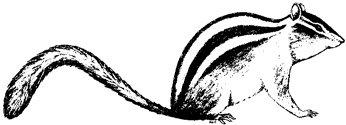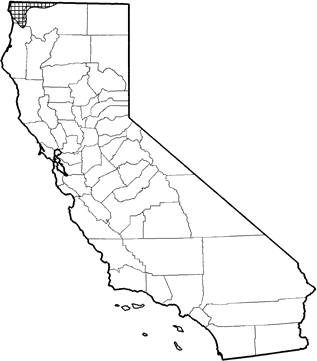
Siskiyou Chipmunk
Distribution, Abundance, and Seasonality
DISTRIBUTION, ABUNDANCE AND SEASONALITY Locally common, permanent resident of mixed conifer, redwood, and Douglas-fir forests from sea level to 2000 m (0-6562 ft) in the northwestern region of the Klamath and North Coast Ranges (Johnson 1943).

Range Map
Specific Habitat Requirements
Feeding: Herbivorous; forages principally on log-strewn forest floors and into adjacent chaparral; climbs freely on trunks and lower branches of large trees (Johnson 1943). Food habits of T. siskiyou unknown, but the closely related T. senex feeds on fungi and seeds of forbs, shrubs, and conifers.
Cover: Uses brush, logs, stumps, snags, thickets, rock piles, and burrows as cover.
Reproduction: Lines burrows with dry grass and moss. Also uses tree nests while raising young.
Water: No data found.
Pattern: Uses conifer forests, especially in mature, open stands with shrubs and large-diameter logs, stumps, and snags available.
Species Life History
Activity Patterns: Diurnal activity. May become torpid during winter months.
Seasonal Movements / Migration: Not migratory
Home Range: In Washington, home ranges of T. townsendii females overlapped very little, suggesting exclusive use (Meredith 1972). In Oregon, home ranges varied from 0.5-1.0 ha (1.25-2.47 ac) (Gashwiler 1965).
Territory: No data found; probably same as home range (Meredith 1972).
Reproduction: Breeds from April to July; most births occur in May. One litter/yr of 4-5 young (range 3-6).
Niche: May be preyed upon by various mammals snakes, hawks, and owls. Formerly considered a race of T. townsendii (Sutton and Nadler 1974).
Sources & References
California Department of Fish and Game, 1999.
California's Wildlife, Sacramento, CA.
Written by: C. Polite, T. Harvey, reviewed by: M. White, edited by: M. White
Burt, W. H., and R. P. Grossenheider. 1976. A field guide to the mammals. 3d ed. Houghton Mifflin Co, Boston, MA. 289pp.
Gashwiler, J. S. 1965. Longevity and home range of a Townsend chipmunk. J. Mammal. 46:693. Johnson, D. H. 1943. Systematic review of the chipmunks (genus Eutamias) of California. Univ. Calif. Publ. Zool. 48:63-143. Meredith, D. H. 1972. Subalpine cover association of Eutamias amoenus and Eutamias townsendii in the Washington Cascades. Amer. Midl. Nat. 88:102-114. Sutton, D. A., and C. F. Nadler. 1974. Systematic revision of three Townsend chipmunks (Eutamias townsendii). Southwest Nat. 19:199-211.
California Animal Facts | California's Wildlife